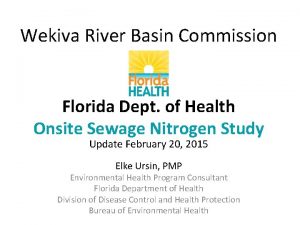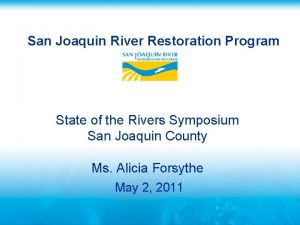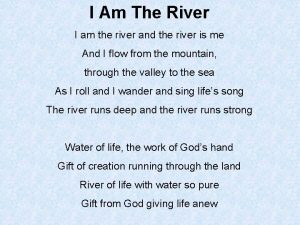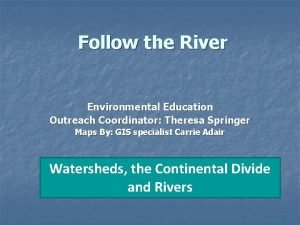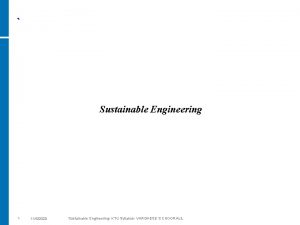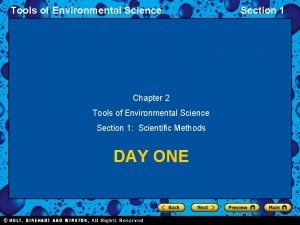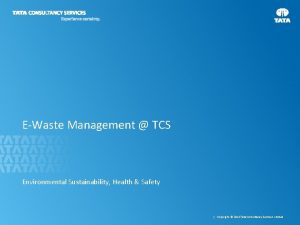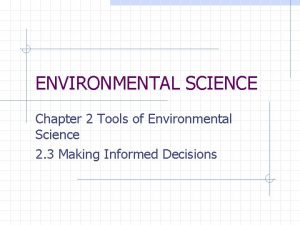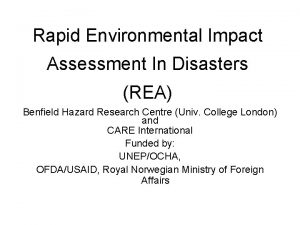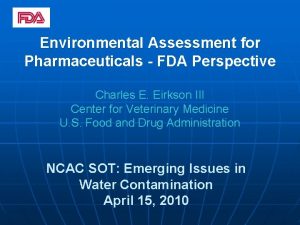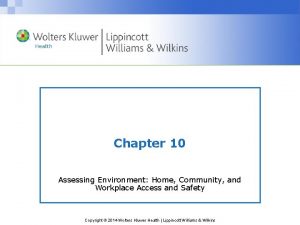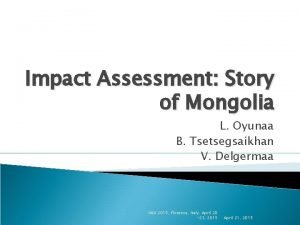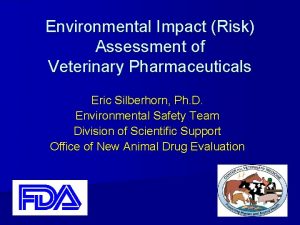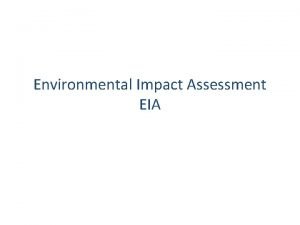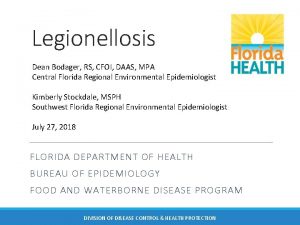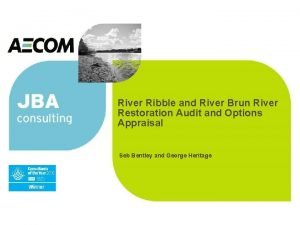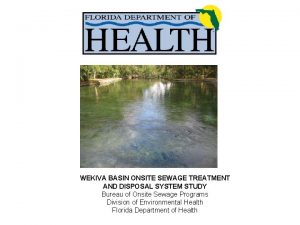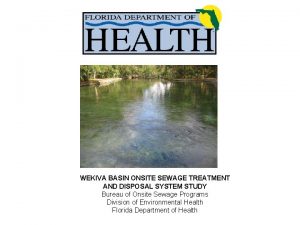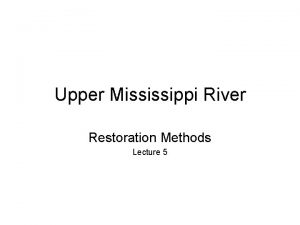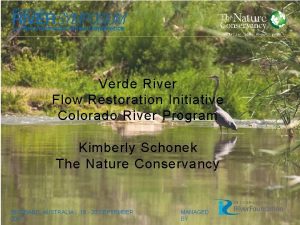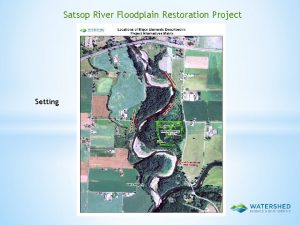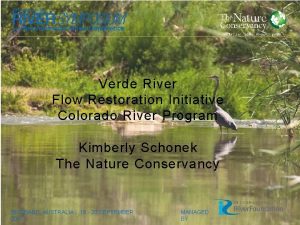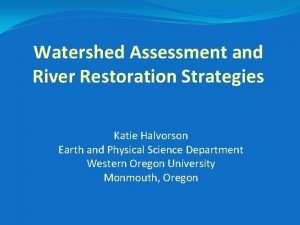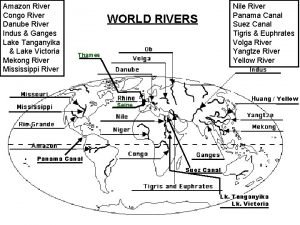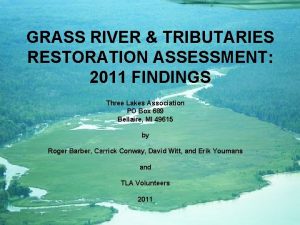Division of Environmental Assessment and Restoration Wekiva River






















- Slides: 22

Division of Environmental Assessment and Restoration Wekiva River, Rock Springs Run, and Little Wekiva Canal Basin Management Action Plan (BMAP) Update Moira R. Homann/Kevin Coyne August 15, 2016

Water Quality Framework Set Water Quality Standards Develop restoration plan Allocate responsibilities Identify projects • Infrastructure • Best Management Practices (BMPs) Restoration Basin Management Action Plan Monitor and Assess Waterbodies Establish schedules Collect data Identify success Analyze and verify criteria List impaired waters Determine pollution problems Gather additional data Model water quality Adopt pollutant reduction targets 6/30/2015 Total Maximum Daily Load Development Impaired Waterbodies (303 d) List 23

Wekiva River, Rock Springs Run, and Little Wekiva Canal BMAP • Adopted October 2015. • 513 square miles. • Area includes roughly half of the Wekiva groundwater basin drawn by the St. Johns River Water Management District (SJRWMD). • Including the springs that contribute to the Wekiva River, Rock Springs Run, the Little Wekiva River, and Blackwater Creek. • Phased BMAP. • Total reductions addressed in fiveyear increments. • In 2018 the BMAP will be revised to include requirements set forth in Chapter 2016 -1 Laws of Florida. 3

BMAP Characteristics • Florida Watershed Restoration Act (FWRA), Section 403. 067, Florida Statutes (F. S. ). • DEP method for restoring water quality to an impaired waterbody. • BMAPs are adopted by the Florida Department of Environmental Protection (DEP) through a Secretarial Order. BMAPs are enforceable through the following: • • • The authority of the adopted BMAP itself. National Pollutant Discharge Elimination System (NPDES) permits. 4

Florida Springs and Aquifer Protection Act 5

Florida Springs and Aquifer Protection Act • Chapter 2016 -1 Laws of Florida. • Signed into law on January 21, 2016. • Florida Springs and Aquifer Protection Act (Act). • Provide for the protection and restoration of Outstanding Florida Springs (OFSs); 6

Outstanding Florida Springs 7

Elements of Act • • • TMDL needs to be achieved no more than 20 years after adoption of the BMAP. Delineation of a Priority Focus Area (PFA). Local governments (county and municipal) within a spring BMAP area must have fertilizer ordinance. • • OSTDS remediation plan required. • • Deadline is July 2017. DEP has a model ordinance available. Meets Section 403. 9337, F. S. If DEP identifies OSTDS as contributors of at least 20% of non-point source nitrogen pollution in the PFA, or if DEP determines remediation is necessary to achieve TMDL. BMAP reporting requirements. • • 5 -, 10 -, and 15 -year milestones. Detailed project and financial information. 8

Elements of Act (cont. ) • • Identification of point sources and nonpoint source categories with estimated load allocations (Nitrogen Source Inventory and Loading Tool - NSILT). Proposed restrictions within PFAs. • • Directed to new development. Prohibition on some activities: • New domestic wastewater disposal facilities unless they meet treatment requirements. • Applies to >100, 000 gallons per day unless it meets standard of 3 milligrams per liter (mg/L) total nitrogen on an annual basis or better, if needed. • BMAP effluent standards apply in these basins. 9

Elements of Act (cont. ) • Prohibitions, continued: • • New hazardous waste disposal facilities. Land application of residuals, unless there is an approved nutrient management plan. New OSTDS on lots smaller than 1 acre, IF the specific systems conflicts with an OSTDS remediation plan in a BMAP. New agricultural operations that do not implement best management practices or perform monitoring under an approved plan. 1

Elements of Act (cont. ) • After the BMAP is adopted: • Funding--Provides stakeholders the opportunity to access funding sources that require an adopted BMAP to be considered for receiving funds. • Focus--Allows the development of PFAs for the listed springs and determine the required actions within the PFA. • Inventory--Allows refinement of the NSILT to determine the required estimates of a project’s nutrient load reductions. • Pilot Projects--Allows development and implementation of innovative pilot BMP activities and effectiveness determination prior to required rulemaking. 11

Nitrogen Source Inventory and Loading Tool (NSILT) and OSTDS Remediation Plan 12

NSILT • Planning tool that provides the best available assessment of where nitrogen is currently being applied in the BMAP area. • Estimates nitrate loads from multiple sources: • • • Atmospheric deposition. Agricultural and nonagricultural fertilizer. Livestock waste. Septic systems. Wastewater application. • General approach. • Identify categories of land use that are potential nitrogen sources. • Estimate nitrogen input at the land surface. • Attenuation by type of source. • Apply attenuation based on groundwater recharge. • Higher recharge rate lower attenuation. • Calculate the estimated nitrogen load to groundwater. 13

Wekiva NSILT • The department will develop an NSILT for the Wekiva basin to: • Help provide information on the significant sources of nitrogen in the groundwater contribution area, and • Estimate their loads to groundwater in the area covered by the BMAP. 1

OSTDS Remediation Plan • If the nitrogen inventory identifies OSTDS as a source greater than 20%. • Develop a Wastewater/OSTDS Remediation Plan to help achieve TMDL reduction for these sources within 20 years. Specified by the following: • 2016 Legislation. • Chapter 2016 -1 Laws of Florida (Section 373 807, F. S. ). 15

OSTDS Remediation Plan “Prongs” • Projects/Management Strategies. • Wastewater management plan identification and development (projects). • Identify additional cost-effective feasible projects that of and includes strategies financially • Scientific information. • Collect and evaluate credible scientific information on the effect of nutrients, particularly forms of nitrogen, on springs and springs systems • Data availability and sufficiency • Research/studies (planned/underway/completed). • Public education. • Plan to provide reliable, understandable information about OSTDS and springs. • Provide residents with understandable information about the impacts of nitrogen loading and proper and effective wastewater management. 16

OSTDS Remediation Plan • Plan needs to: • Allow for BMAP revision by July 2018. • Include development of 5 -year, 10 -year, and 15 -year goals. • Include detailed plan to meet TMDL in 20 years. • Include elements of each of the three “prongs”. • Projects. • Science. • Education. NOTE: Other source categories will be considered outside this committee 17

OSTDS Advisory Committee 18

Advisory Committee: Introduction • OSTDS Advisory Committee members: • Represent the sectors that are affected by the OSTDS Remediation Plan. • Have expertise to lend to the process and to successful outcomes to reduce nitrogen loadings from OSTDS sources. Sector Representative Entity/Group City *+ Nicholas Mcray/Mary Hamilton Julie Bortles Kim Ornberg Jessica Schilling Danielle Marshall/Travis Hollman Public/Private Utilities *+ Megan Nelson/Elisabetta Natale Environmental Interest Homeowners + Michael D. Cliburn/Jay Exum Lake County Orange County Seminole County City of Apopka City of Altamonte Springs Orange County Utilities Department Friends of Wekiva, etc. Charles Whitaker Property owners Roxanne Groover Florida Onsite Wastewater Association (FOWA) DOH *+ County Bart Harriss/Stephanie Daugherty/Nancy Smith *+ Other interests + + 19

Purpose of OSTDS Committee • Purpose: • Provide ideas, comments, suggestions and concerns to DEP toward reducing nitrogen loads from on-site treatment and disposal systems (OSTDS) sources through development of an effective and cost-efficient OSTDS Remediation Plan • Assist with specialized technical discussions and topics to be researched. • Provide information back to community leaders, decision makers, and homeowners. 20

Thank you! Questions? 21

Contacts • Tom Frick, Director, Division of Environmental Assessment and Restoration, Thomas. Frick@dep. state. fl. us • Kevin Coyne, Administrator, Watershed Planning and Coordination Section, Kevin. Coyne@dep. state. fl. us • Rick Hicks, Administrator, Groundwater Management Section, Richard. W. Hicks@dep. state. fl. us • Moira Homann, Wekiva River, Rock Springs Run, and Little Wekiva Canal BMAP Coordinator, Moira. Homann@dep. state. fl. us • Kenny Hayman, Senior Attorney, Kenneth. Hayman@dep. state. fl. us 31 22
 Wekiva river basin
Wekiva river basin San joaquin river restoration program
San joaquin river restoration program Channelisation geography
Channelisation geography I am the river and the river is me
I am the river and the river is me Short division vs long division
Short division vs long division Long division terms
Long division terms Polynomial long division definition
Polynomial long division definition Quadratic long division
Quadratic long division Green river watershed
Green river watershed Follow the river environmental
Follow the river environmental Grand river environmental
Grand river environmental Wireless health
Wireless health Sustainable engineering syllabus
Sustainable engineering syllabus Chapter 2 assessment environmental science answers
Chapter 2 assessment environmental science answers Environmental management system at tcs
Environmental management system at tcs Chapter 2 environmental science
Chapter 2 environmental science Rapid environmental impact assessment in disaster
Rapid environmental impact assessment in disaster Fda environmental assessment
Fda environmental assessment Workplace environmental assessment
Workplace environmental assessment Eia meaning
Eia meaning Environmental risk assessment veterinary
Environmental risk assessment veterinary Environmental auditing
Environmental auditing Facility manager
Facility manager
